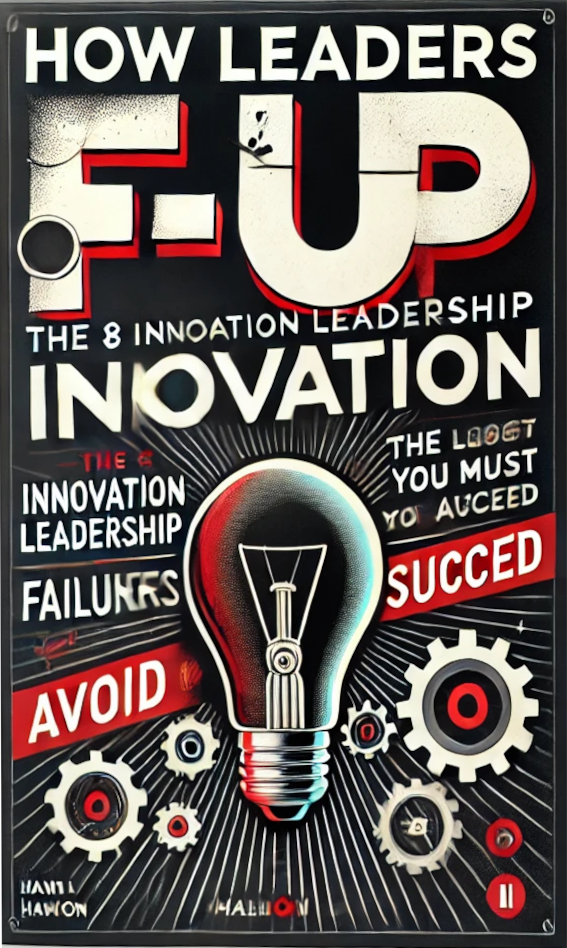
Coming in 2025
How Leaders F-Up Innovation
Innovating is Hard Enough
The 8 Innovation Leadership Failures
You Must Avoid to Succeed
Marc Drucker
Author's Note
Innovation is both critically important to business and, in my opinion, profoundly misunderstood. A search on Amazon.com reveals over 50,000 books about how to innovate. Yet data shows leaders tend to get it wrong more often than not.
This book emerged from countless conversations with leaders who desperately want to understand innovation but find themselves trapped by rigid frameworks and mythical success stories. Having developed and launched successful innovations across diverse business categories, corporate cultures, and organizational structures, I’ve learned that there isn’t a singular path to innovation.
In fact, as demonstrated by successful innovations from companies as varied as Apple and Valve, Tesla and BYD, OpenAI and Hugging Face, Amazon and Patagonia, there are multiple routes to success. What these innovations share isn’t a perfect methodology, but rather a common thread: their leaders are skilled at avoiding critical mistakes.
I’ve attempted to illustrate my thesis using references to well-known products and companies. Although I’ve done my best to research and provide references, I can’t say if my stories are actually accurate. So, take them with a grain of salt and use them as the story-telling examples they are.
As you read this book, my hope is that you’ll discover: while there’s no universal blueprint for innovation, there are eight ways leaders tend to f-up innovation.
My Story:
I believe I am a very average innovator. Rather to say, that my experience in innovation is typical of most. I studied at a top design school, The Art Center in Pasadena, California and earned an MBA at Babson College, which, as of 2025, had been ranked #1 in entrepreneurship for 31 consecutive years.[i] I worked for both consultancies and in-house teams. I’ve had the roles of product designer and innovation consultant. What I believe gives me a unique insight on how to make innovation work are the executive roles I’ve also held; Chief Product Officer, Chief Strategy Officer, Chief Marketing Officer and Chief Operating Officer. The companies I’ve worked for have included medical device startups, niche luxury goods brands, global food-and-beverage/CPG manufacturers, and domestic home appliance companies. In these roles I’ve grown my perspective about innovation to better understand the multitude of ways it can be practiced and its role in achieving the larger business performance goals.
I recently estimated that my innovation work has so far created more than $4.5 Billion in new revenue. As a designer / innovator I’ve won a number of awards from global organizations including the Industrial Designer’s Society of America (IDSA), the Good Design Awards, Star Packaging and have been credited on nearly 30 patents. I’ve innovated products as small as a pen and as large as a military transport truck. My innovations have included breakthrough technology, such as the commercial appliance that freezes water instantaneously, a chair that takes your vital signs while you’re waiting to see your physician, smart packaging that harvests radio frequencies to power continuous food safety monitoring and innovation management software that uses AI to leverage a company’s prior innovations to solve today’s challenges. Many of my innovations have also been incremental, such as a household fans, humidifiers, toasters and air fresheners that simply work and look better and are thus bought more often than their competition. However, most of my innovation work falls somewhere in between; new products and services that don’t define a new category but redefine what is possible. These include marker that redefined its brand, a kitchen appliance that made cocktails at the push of a button, a portable IV pump that didn’t need batteries or to be plugged in and an app for making pharmaceutical trials faster and more accurate. My innovations have resulted in new product lines, new operating divisions, startups and a joint venture between two multi-billion-dollar global corporations.
I’ve also had my fair share of failures. Bill Gate’s quote sums up their contribution to my understanding of innovation: “It’s fine to celebrate success, but it is more important to heed the lessons of failure.”[ii] More often than not the failure wasn’t that the intent of the innovation itself. The root cause of the failures was in the decisions leadership, often the CEOs, made. These decisions, eight of which I saw repeated by leaders of companies large and small form the basis of this book.
[i] Babson College. “College Rankings and Accolades.” Babson.edu. Accessed March 28, 2025. https://www.babson.edu/about/babson-at-a-glance/college-rankings-and-accolades/. [ii] Gates, Bill. The Road Ahead. New York: Viking, 1995.Featured in




New Release
Explore Sam's Books
Philosophy
Lack of Comprehension
The Faucibus in ornare quam viverra. Malesuada nunc vel risus commodo viverra maecenas accumsan lacus. Ornare arcu dui vivamus arcu felis bibend a fay.

